Tanks and Armored Vehicles of WW1
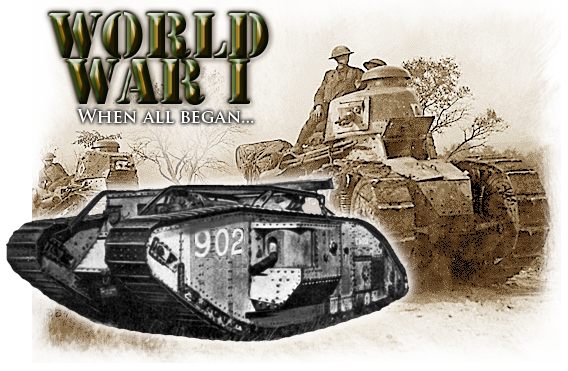
When and where was the tank first imagined, developed, and its evolution in combat from 1916 to 1918, as well as tactical development during the interwar period.
The Great War
 Austro-Hungary
Austro-Hungary
 Belgium
Belgium
 British Empire
British Empire
 France
France
 German Empire
German Empire
 Italy
Italy
 Russia
Russia
 USA
USA
Part I: Introduction
The tank concept can actually be traced back to the Renaissance period. The first to put it on paper and effectively build a model (possibly at a 1:2 scale) for proper military purposes was the Florentine genius, Leonardo Da Vinci. His "tank" mainly originated from a series of protected-ram experiments and a proposal to Leonardo's protector, the powerful Condottiere Ludovico il Moro (then Duke of Milan). It was not intended to attack fortifications, but to break the "pike and shot" formation, a solid, mobile and massive human "fortress" formed of a large number of pikemen surrounded by smaller detachments of arquebusiers.
WW1 centennial: All belligerents tanks and armored cars - Support tank encyclopedia
This formation had dominated the battlefield for almost three centuries and was very effective, as the arquebusiers delivered continuous fire while being protected by a massive wall of pikes against cavalry and infantry alike. The wooden structure of Leonardo's tank was sloped and was thick enough to absorb bullets and deflect cannonballs, while at the same time delivering a punishing fire all around from its many light culverins (a simplistic type of medieval musket/cannon).
The main problem was actually the way such a wooden monster could be moved. Only human or animal power was available back then, and even if Leonardo showed, in his drawings, cranks and shafts for two men, these would have been far from sufficient for pulling the sheer weight of this mobile fortress while permitting it to fire at the same time. Modern calculations and reconstitutions, based on Leonardo's unique manuscript, showed it would have weighed nearly 2 tons.
Another strange feature, but faithful to Leonardo’s drawings, was a purely mechanical propulsion. While mastering clockwork devices, Leonardo had produced some "robots", including a walking lion which was displayed at Francis I' court. However, the "tank" wouldn't have been equipped with such a device, as it would have had to cope with difficult terrains under adverse conditions. Ludovico il Moro, although impressed, never ordered such a contraption built.
Part II: The Deadly Equation
Nobody was prepared for the bloody stalemate which prevailed during the First World War. Officers from all countries had in mind brash pictures of daring offensives with waving flags and blaring trumpets, epic cavalry charges and massive infantry squares marching under fire, bright uniforms, tactical genius and glory. This was quite a romantic view which was familiar to the commoners, the very same ones who then embarked with happiness and chants onto the trains. But, quickly, the grim reality of an attrition war became apparent, with death on an industrial scale. The early French offensives sank before the whirling staccato of the German Mauser machine-guns.After a full retreat, the German offensive was miraculously stopped on the Marne, a few dozen miles north-east of Paris. From Belgium to Switzerland, all the opponents entrenched themselves. Artillery, barbed wire and machine guns took their toll on every offensive. On the German side, some attempts to break the stalemate included assault squads equipped with portable machine guns and grenades, as well as gas and flamethrowers. To blow up the trenches, artillery was insufficient, so another vicious weapon was used: the mine (in fact already in use since late medieval times).
Despair started sinking in after it was seen that all major offensives, like those of Nivelle in 1916, the Von Moltke offensive at Verdun or the dreadful Somme offensive by Sir Douglas Haig, were literally drawn in blood. To deal with this deadly equation, various experiments were made, some of them quite odd-looking or simply pathetic- the personal iron armor, the portable iron shield, a wooden structure covered with iron and then machines, the electric tank, the "mobile fortresses", the "automatic wheels" and pedrails to blow up the barb wire. None showed any promise.
The idea of the "tank", in the modern meaning of the word, appeared simultaneously in France and in Great Britain. In the latter, it was due to Lt. Col. Ernest Swinton, and in the former due to Col. Jean Baptiste Estienne. Both advocated the use of the Holt Tractor, which was then largely in use with the Allies as a gun tractor. This led to further developments and, despite many setbacks, culminated in 1916 when the first operational tanks were put to the test.
Part III: The Holt Tractors
The invention of the Caterpillar track and its practical application by Benjamin Holt gave birth to a new land transportation system with great torque and pulling power, up to agricultural tasks and with good military potential. Internationally known and widely used by agriculturally-reformed large farms, but also moving and transporting logs in the New World, the Holt tractor was already a mechanical legend. The flagship model, the 120 Holt, had been marketed since 1914. It was purchased in large numbers, first by Great Britain and then France, to be used as an artillery tractor. Nearly 10,000 were used. So, it was natural to choose a large tractor to pull the weight of an armored box, its equipment and fuel. It took little time to discover the best suitable model for the worst terrains.The Holt 120 (for 120 hp), which was much more capable than the model 70, was chosen to tow a weight of 10 tons. The problem encountered by the engineers who tried to adapt the tractor to this new task, was the quick onset of issues with the resistance of the track shoes. This was particularly clear on the testing of the Lincoln machines ("Little and Big Willie"). The former was created especially for the test of extra-large pads, able to bear the brunt required, but also a suitable suspension system.
Tests were thus conducted on both sides of the Channel, the British with their prototype "Big Willie" creating the basis of their first operational tank, the Mk.I. The French, under the leadership of Colonel Estienne, quickly devised the Schneider CA, but production was not without difficulty.
Great Britain was the first to deploy its Mk.I tanks during the Somme offensive, especially at Flers-Courcelette, on Sept. 16, 1916, where 49 tanks were deployed. Looking more specifically at this model, the Holt chassis had, after many changes to specifications, been completely reworked. Being initially too short, it was considered unsuitable for crossing trenches. It had nevertheless preserved the Caterpillar suspension, and many other details of the "Big Willie", the prototype of the Mk.I, also known as the "Mother".
Weighing nearly 30 tons, with a Foster-Daimler engine delivering about 105 hp, the Mk.I could move only with agonizing slowness. The weight was the result of a complete redesign of the chassis for the best possible crossing capabilities. In this case, the huge tracks, going all the way around the machine, enclosed a narrow central hull hosting the eight-man crew. Weighing nearly 30 tons, with a Foster-Daimler engine delivering about 105 hp, the Mk.I could move only with agonizing slowness. The weight was the result of a complete redesign of the chassis for the best possible crossing capabilities. In this case, the huge tracks, going all the way around the machine, enclosed a narrow central hull hosting the eight-man crew.
Part IV: 1916 - First Blood
Part IV: 1916 - First Blood
These two models, the Mark I and Schneider CA-1, were the first tanks in operational history. It took almost a year and a half of painful technical development and testing, strong will from a few promoters, and administrative battles and support from the highest level for this idea to be born. The concept was developed in parallel in the United Kingdom and in France. The latter had a slight advantage at first, but the former managed to produce and deploy their tanks faster. These famous diamond-shaped models remain, by far, the best known visual icons of the conflict. These two models, the Mark I and Schneider CA-1, were the first tanks in operational history. It took almost a year and a half of painful technical development and testing, strong will from a few promoters, and administrative battles and support from the highest level for this idea to be born. The concept was developed in parallel in the United Kingdom and in France. The latter had a slight advantage at first, but the former managed to produce and deploy their tanks faster. These famous diamond-shaped models remain, by far, the best known visual icons of the conflict.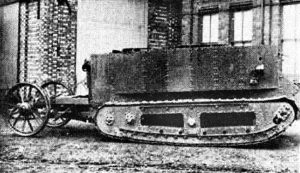
Starting with the "Mother", the prototype of the series, the British built close to 2,000 units in five versions until 1919, by sticking to their proven formula and constantly improving it. The French however, made the choice of having multiple separate designs. The first, given by Joffre to Schneider, the second, designed by the army, for the army, by Saint Chamond and the third, developed from private funds, the Renault FT. Finally, the design choice of the latter would set a new standard and impose a great leap forward in tank design.
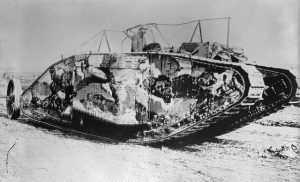
For the British vehicles, the main armament was not located in a turret (this was tested, but rejected for reasons of stability), but in a "barbette", hosting a naval gun, the famous "6 pounder" (57 mm) that was common on the deck of any ship, from destroyers to the largest battleship. The concept had been well-proven and the weapon was available in large quantities. The "barbette" was the preferred system, placed into the center of the lozenge. W G Wilson, who led the project, as specified by the army, split the Mk.I into two different series. 250 Mark I’s were "males", armed with two 6-pdr pieces, and the others "females" - equipped only with machine guns.
The latter exchanged their expensive water-cooled Vickers with more recent models, the Lewis and the Hotchkiss air-cooled machine guns. Besides the four operators for the guns, the other four crewmen were dedicated to manoeuvring - operating the gearbox, brakes and differentials for the two tracks. It was a complex system, which posed coordination difficulties, mostly because of the unbearable environment- scorching heat, deafening noise, petrol fumes, oil and toxic exhaust gases (there was no wall separating the engine from the crew). To this was added the internal finish of the armor plates, made up of boiler steel. Where there was an impact, even if the projectile did not penetrate, an internal metal explosion was triggered, filling the crowded interior with shrapnel. In fact, crews quickly adopted a complete protective outfit (thick leather belt, leather helmet with chain-mail, etc).
The French, meanwhile, devised a tank that looked more like the experimental Little Willie. Ultimately, the Schneider CA was basically an armored box with a frontal gun and machine-gun ports and ballmounts, mounted on a modified 75 Holt chassis. The original idea of Col. Estienne envisioned it as an armoured transport vehicle, embarking troops in an "armoured carriage", crossing no-man's land safely, and deploying them right at the entrances of the enemy trenches. However, after tests, the engine was found incapable of supporting the weight of the main armoured body.
The idea was deemed impractical and abandoned, returning to a pure tank, for clearing machine gun nests, fortified positions, and preceding and supporting the infantry assault. The length of the tractor train, although already increased, was found to be insufficient for crossing wide trenches, but a tail "sabot" contributed some improvement. In addition, the vehicle was high, with relatively low ground clearance. The 55 hp Schneider engine was barely able to propel the fourteen tons it had to carry. Only 150 had been built by mid-1917, as the project suffered delays, when the production lines stopped and shifted to a supply model. With the opening of the training school at Beaulieu, the high attrition rate due to insufficient maintenance in adverse conditions was significantly reduced, but inadequate armor and poor placement of fuel tanks contributed to its precipitous withdrawal.
Part V: 1917 - Full armor on the Western Front
The engagements of 1917 brought utter disillusionment, but also a lot of hope about the future of the tank. Since the first offensive actions on the Somme, the German Army had learned how to deal with this new threat and gained the upper hand, while using their artillery or improvising at infantry level. It was indeed shown that, despite its apparent inefficiency against tank armor, machine-guns could cause spalling, which meant that the poor quality plates fractured into small pieces, similar to shrapnel. These injured the crew and disabled the transmission, engine, or other mechanical parts. Throwing a grenade over the less protected roof was also found quite effective. But the most efficient way to destroy these lumbering targets was light, agile, field artillery. German gunners quickly learned to destroy tanks while remaining out of reach of direct fire, and artillery observers learned how to anticipate the movement of these vehicles during an artillery barrage.The first French tank battle took place on April, 16, 1917, during the Nivelle Offensive. It involved most of the Schneiders available (132), engaged at once at Berry-au-Bac. This was a complete disaster, as the German gunners had already received instructions on how to deal with tanks and were ready for them. For the few that reached a practical firing range (most had been lost due to poor maintenance, breakdowns, or just bogged down en route), the German gunners targeted an obvious weak point, the badly-placed front fuel tank. One by one, all survivors of the muddy lunar-like landscape were blasted away, before even getting into position to cause some damage. Because of this, they were later called "mobile crematoria".
This was just a footnote in the immense and futile slaughter of soldiers which was part of these series of massed frontal assaults. However, they achieved some objectives by May, with the capture of 187 guns, taking of 28,500 prisoners, and inflicting around 160,000 German casualties for some 200,000 French casualties. Despite their poor results, the Schneiders and St. Chamonds (92 in all) were once more engaged at the Battle of La Malmaison in October. But the results were similar, and due to the soaked terrain, the attrition rate was even greater. Few tanks reached the German lines. After this, the French Army, led by General Pétain, as he himself put it, preferred "waiting for the tanks (the numerous and promising Renault FTs) and the Americans".

On the British side, in June and July in Flanders, around 200 tanks were engaged, with mixed results. By November, the British Army led another major offensive with 187 tanks, at the battle of Cambrai. It was the first time the new Mark IV was deployed in such numbers. This tank was improved in every way over its predecessors, including armor able to withstand the German armor-piercing bullets. In total, 476 tanks would be deployed in these offensives, and 178 lost, some of which were later recovered by the Germans, after their successful counter-offensive, using Sturmtruppen.
By December 3, Sir Douglas Haig ordered a general retreat from the Hindenburg Line. The territorial gains were real, but they largely involved better coordination between infantry and artillery to succeed. British Colonel J.F.C. Fuller, chief of staff of the Tank Corps, had his troops succeed on the battlefield despite a horrendous attrition rate, and tanks indeed helped to secure a breakthrough, although this was later wasted by the complete absence of coordination with infantry. Some were also engaged in urban combat, to their dismay.
First experiences during the early months of 1917 had shown how much the Allied tanks were prone to breakdowns, and that they were severely underpowered and vulnerable against gunfire. But they also proved, first thanks to the element of surprise, and thereafter because the Germans were unable to formulate a response, that their concept was sound and they could possibly make the long-awaited breakthroughs. During the last months of 1917 new models were being developed. The British had improved the Mk.I/II and were able to deliver a brand new mass-production model, the Mk.IV.
It would be the spearhead of all offensives in the British sector. At the same time, the man behind the Mark I, William Tritton, devised a new kind of machine, the light tank. With the standard Mark I clearly being too slow to operate in the way they were originally meant to function, he designed a cavalry tank, which was fast enough to exploit breakthroughs. This was the Mark A "Whippet". But late 1917 and mid-1918 offensives showed the effectiveness of combined-arms tactics that employed infantry support and (real) cavalry alongside tanks.
Part VI: 1918 - The Last Offensives
Part VI: 1918 - The Last Offensives
As the lessons drawn from battle experience were properly digested and integrated, two new models were introduced. On the British side, the Mark V with Wilson's epicyclic gearing, which greatly simplified steering (one driver was now sufficient), and later lengthened versions, the "stars", to cross the large German anti-tank trenches. On the French side, this was the nimble Renault FT.This revolutionary design was a Ford-inspired industrial mass-production vehicle and helped to secure the right number of tanks at the right time. Although the FT was not able to sustain gunfire and was too small to effectively cross large trenches, the combination of gun-armed and MG-armed vehicles and new tactics of close support with infantry helped to achieve far better results than before. The little Renault was there to "overwhelm" the enemy.
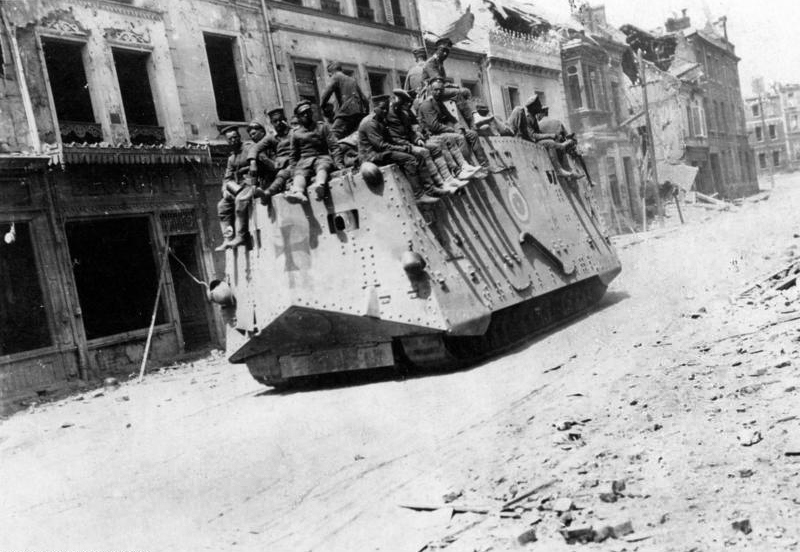
The Battle of Villers-Bretonneux was just one of these events, which occurred on April, 24, 1918. It saw the first tank-to-tank engagement of the war, and the first in history. Although the Germans were confident in their antitank tactics and their own assault squads, the Kaiser authorized tank development, which led to the A7V, as well as other German types which were never ready on time. The Sturmpanzerwagen A7V was a colossus of a tank- of the "box-type". Based on a short Holt chassis, this lumbering beast was even slower than an infantryman walking at normal pace, but impressive, with one gun and bristling with machine-guns.
On that day, a single one was spotted by a Mark IV platoon. The platoon comprised one "male" gun version and two "female", MG-armed only. After two near-misses and one hit, both "females" disengaged, and the "male" resumed the gunfight. After very close near-misses, the A7V disengaged, thus ending this rare encounter in a draw.
With the combination of new tanks available en masse, and fresh American troops, the Allies seemed to gain advantage in the last months of the war, just after the German great summer offensive, which saw few tanks engaged. The German high command showed how small, well-trained and well-equipped elite infantry squads could secure a quick breakthrough and deep penetration in enemy territory, without using any tanks. However, after this advance without clear objectives, and over-extended lines, the Allies took the offensive again, and their counter-attack led to the near destruction of these experienced forces.
Despite the great successes that had been achieved and the combination of infantry, artillery, aircraft, and tanks reached its zenith near the end of 1918, the Germans still inflicted punishing losses to the French and British tank units. At the battle of Amiens in August, for example, no less than 72% of the Allied Tank Corps was destroyed in the first four days of the offensive. By the 64th day of the battle, 41% of British tanks engaged had been destroyed in action. On November 5, only 8 were left for the whole the British tank corps. Most losses were attributed to direct artillery fire, new grenades, new AP ammunition, and mortars. The technology of the time prevented the use of thicker armor, due to the lack of engine power.
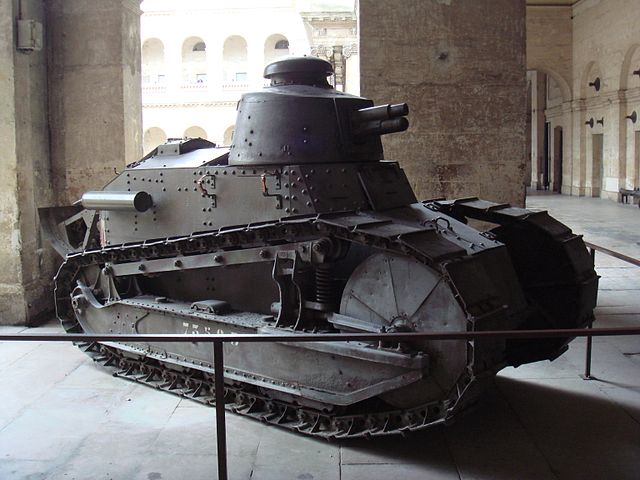
In France, grand plans for the last armoured offensive, of a massive scale, were put on paper by Col. Fuller and Col. Estienne, the latter speaking of "swarms of light tanks" to overwhelm the enemy. The Renault FT, of which over 14,000 units had been envisioned to be produced in France, USA, and Italy, was to be at the forefront of these offensives. Two new tanks were in active development by 1918, the gargantuan FCM-1 and a rhomboid tank with tracks running along its full length, in the British fashion, and the Saint Chamond 2. At the same time, the British had also been innovative. They built the first self-propelled artillery, the Gun Carrier Mark I (carrying the BL 60-pounder field gun), lengthened variants of the Mark V, and the "stars" designed to pass the very large trenches of the Hindenburg line. William Tritton and Major Wilson worked on rival projects, the Mark B and the Mark C, both replacements for the "Whippet". At the same time, a joint-venture between the UK and the USA, for a new heavy model to be built en masse, mostly in the United States, had successfully passed all tests and was ready for pre-production: the Mark VIII "Liberty" tank.
However, the German revolution came as a real surprise. Berlin was in full revolt, the Kaiser was deposed, and the soldiers on the front felt betrayed, leaving no choice but a humiliating Armistice. Subsequently, nearly all previous tank mass-production series were cancelled. However, some models were produced through the early twenties, in order not to lose the benefit of costly research and development. The Mark B "Whippet" and Mark C "Hornet" had 152 units delivered by 1922 and 151 units of the Mark VIII "Liberty" by 1923. In France, 10 FMC-1 had been finally delivered at an astronomical cost by 1923. No modern tank was to be planned in France before 1930, and only cosmetic changes to the basic FT took place (like the Renault NC 1/2/3).
Part VII: Winter Wars - Russia & Poland
The Versailles Treaty, signed on June 28, 1919, had redefined the map of Europe. Three so-called "buffer states" were drawn on the Baltic coast: Lithuania, Latvia and Estonia. Poland was restored to its former historic borders, occupying most of Prussia and large extents of the western Russian territories and was given the Danzig Corridor to ensure access to the Baltic Sea. Since the Revolution of 1917, the Russian Soviet Federative Socialist Republic was in a state of latent civil war. No Bolshevik committee was invited to the Paris Peace Conference. Even more so, the Allies were inclined to militarily support the exiled, loyalist "White" Russian faction.Before the new territorial gains of Poland, an improvised force of the Ukrainian People's Army clashed with the newly born Republic of Zakopane, which will become later part of the Second Polish Republic (Rzeczpospolita Polska). This was the beginning of a full-scale war, with two major battles, at Lviv and Przemysl, both in 1918. Border conflicts also occurred during this period with the Czechs, culminating in a full-scale war with Czechoslovakia in January 1919. Soon, Poland was declared an independent and sovereign state. The Bolsheviks felt this as a direct threat from their old natural enemy, and the Red Army rushed to the borders. This was the beginning of the Polish-Soviet war of 1919 which spanned two years and ended with the treaty of Riga in 1921.
During this event, the Polish state received military advisers and councilors (mostly former French and British officers, including the young De Gaulle), and of course weapons- rifles, ammunition, Schneider 75 mm guns, but also some French FT tanks.
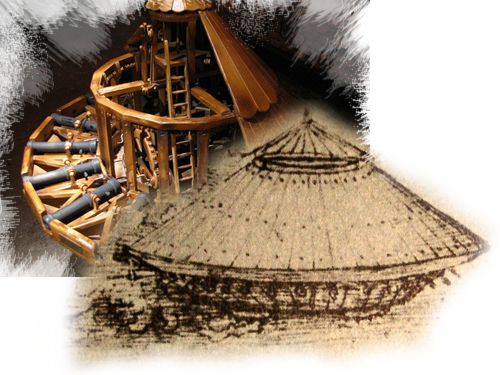
Leonardo Da Vinci was apparently the first to design a wooden tank, which lacked only a suitable propulsion mechanism to turn it into reality. Although impressed by it, Ludovico Sforza, the Duke of Milan, never ordered any to be built. The tank had to wait for four more centuries before appearing on the battlefield.
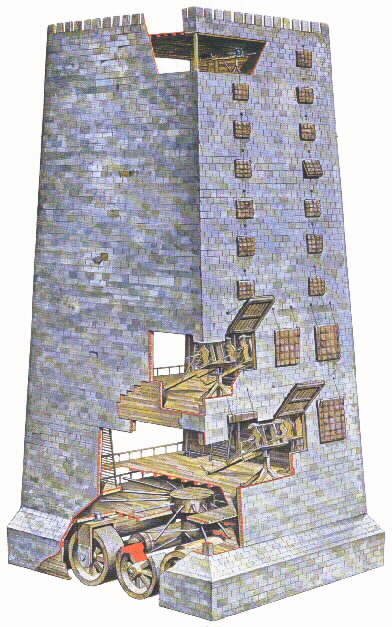
However, the very idea of an armored mobile device could be traced back to the Bronze Age, with the first battering rams, later with the sophisticated siege assault towers of the Assyrians and, 400 years after, with the huge Helepolis of Demetrius Poliorcetes (known as "The Besieger"). Read more about ancient Hellenistic siege towers.
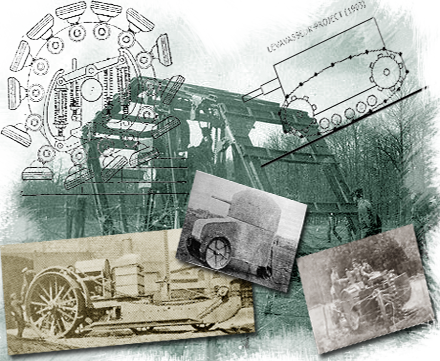
By the beginning of the war, there were already concepts of tanks starting to take shape. Just like the beginning of the automotive industry, many technologies were explored with the same confidence and ingenuity. Therefore steam-powered, electric, even remote-controlled tanks were envisioned, as well as the way to provide traction, open to all fantasies. The pedrail concept, for example, was the great alternative to tracks, proceeding from the same idea, but with bigger elements. To crush barbed wire, many concepts were tried, including the "skeleton tank", with very large overall tracks and the crew compartment inside, of which several variants were tested, including the monster of them all, the Russian "Tsar tank" and its gigantic metallic wheels.
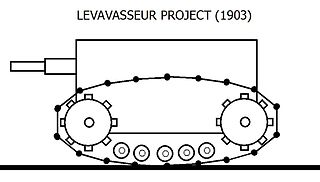
The vehicle pictured above is the French Levavasseur project (1903). With a crew of three, an 80 hp engine, full caterpillars, this “canon autopropulseur” would have crossed the battlefield with ease, but it was eventually buried by the Artillery Technical Committee in 1908. In Lincolnshire in Great Britain, the firm Hornsby built the first functional caterpillars, later to attract great interest from the Admiralty, for possible armed developments.
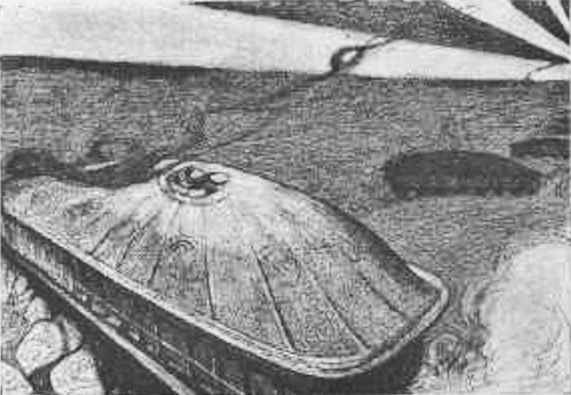
H.G. Wells' "Land Ironclads" novel, first published in Strand Magazine in 1903, had a tremendous impact on the head of the British "Land Battleship" committee in 1915, Sir Winston Churchill. These armored monsters were steam-driven and rolled on eight pairs of giant pedrail wheels.
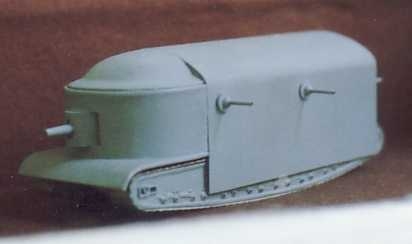
This wartime project, the "Flying Elephant", was closer to the concept of land battleship than ever. After conceiving the Mark I in 1915, William Tritton envisioned a new kind of shell-proof tank. Such requirements called for a massive, heavy hull with 51 mm (2 in) armor plates and the associated powerplant, which, in turn, needed room. As a result, the Tank Supply Committee approved a single prototype in June, plans being ready by August 1916. Although the overall dimensions were not so impressive (8.36 m/27 ft long), it weighed 200 tons and had another pair of belly inner-tracks for better traction. The plans were later modified and the armor halved to regain some agility. Twenty units were initially planned for production, but then the whole project was halted. Here is the 1/35 scale model reconstitution at Bovington.
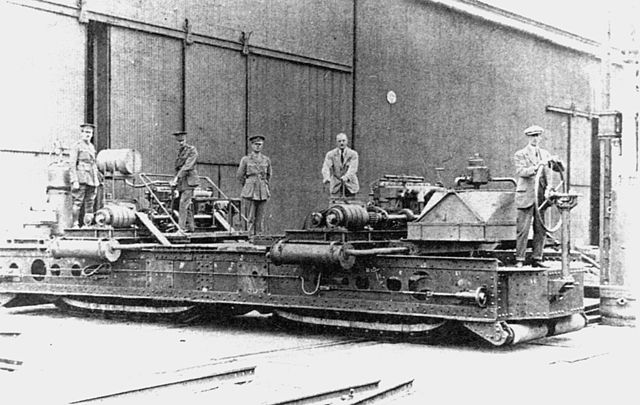
The Stothert & Pitt prototype pedrail landship chassis on trials, in 1915-16, at the Trench Warfare Dept. It weighed 32 tons "unladen", but could still run at 15 mph (24 km/h), thanks to two 100 hp engines. This vehicle came from Murray Sueter and B.J. Diplock, the two coming up with the idea of a 25-ton armored tractor in 1914. By 1915, R.E. Compton designed an armored and tracked APC, and later Churchill himself, enamored with HG Wells’ idea, ordered no less than 12 landships of the Diplock and Wheeled type.
Diplock, nevertheless, developed the caterpillar track in 1910, starting from the pedrail wheel and later pedrail track, giving low friction and low ground pressure. The HG Wells idea stuck to the Royal Naval Air Service and, later, to the Army Staff's minds for much of the duration of the war. Since the Mark I, all British tanks were massive and slow, with naval-inspired barbettes. Until 1918 and the arrival of the Whippet, the light tank idea, suited to replace the traditional cavalry, was not in the minds of the generals, but of the engineers, like William Tritton. Despite this, many pedrail-type tanks were tried, including on the French and German sides, but none made it into production.
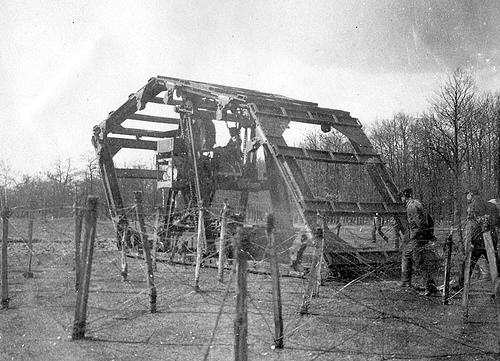
The Boirault Machine, an experimental French "pedrail" rotating frame formed of six large 4x3 m (13ft1 x 9ft10) metallic frames linked together, with a central powerplant inside. The idea was to literally crush barbed wire, but it proved underpowered, fragile, and nearly impossible to steer.
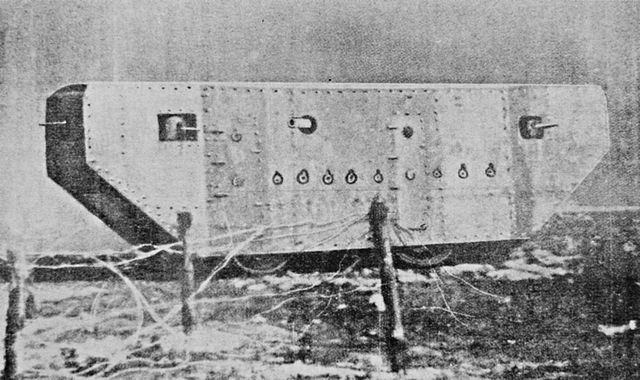
The French Frot-Laffly landship was basically an armored road roller with several machine-gun portholes. On 18 March 1915, it was tried and successfully crushed, as intended, lengths of barb wire, but mobility was reduced.
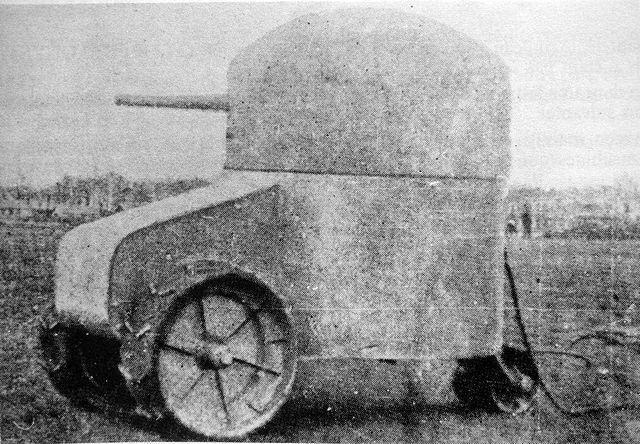
The Fortin ("Fort") Audiot-Gabet looked modern with its electrical propulsion, revolving turret and 37 mm (1.46 in) cannon, but trials showed it was impractical, since electrical power was supplied through a cable. A single shot to this cable and it was stopped. Moreover, the available length of the cable barely allowed even for the short distance to the enemy trenches. The Fortin ("Fort") Audiot-Gabet looked modern with its electrical propulsion, revolving turret and 37 mm (1.46 in) cannon, but trials showed it was impractical, since electrical power was supplied through a cable. A single shot to this cable and it was stopped. Moreover, the available length of the cable barely allowed even for the short distance to the enemy trenches.
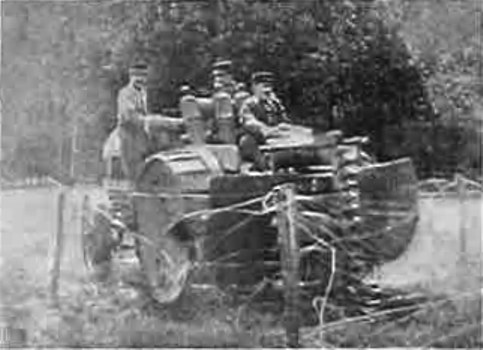
In the same idea of a compactor, with heavy rollers to crush barb wire, the Breton-Prétot machine was tried in January 1915. It had a powered saw to cut through wires and large rollers to crush what was left and enlarge the gap for infantry to follow. It was armored, but the crew was left largely unprotected, and had a Hotchkiss 37 mm (1.46 in) naval gun installed at the rear. However, the lack of mobility of the original Bajac agricultural tractor doomed any production. Jeffery tractors were also considered, but, by mid-1915, it was too late, as the tank design was well-advanced and more promising.
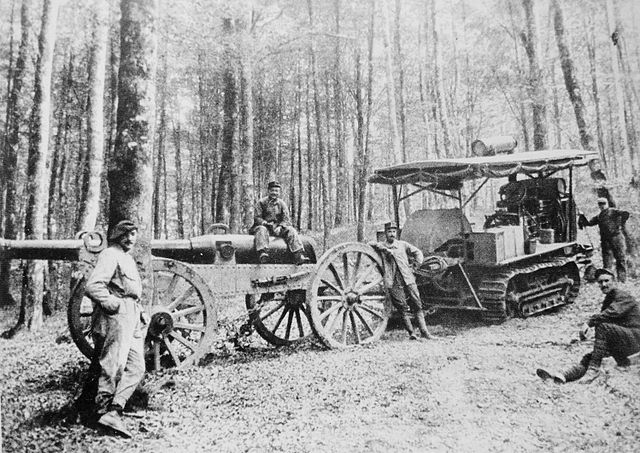
The Holt tractor was instrumental as an artillery tractor, used to carry pieces of ordinance too heavy for horse-drawn carriages on the worst terrain. It was based on the caterpillar track patent. Since these machines were already well known, well-used and purchased in large quantities, with many already-available spare parts, it was not long before engineers and officers tried to have "armored boxes" hastily mounted on top. But this burden proved too much for the extremely muddy and cratered landscape. Nevertheless, "fortune tanks" have been made since during the thirties, forties, and occasionally during civil wars, until recently.
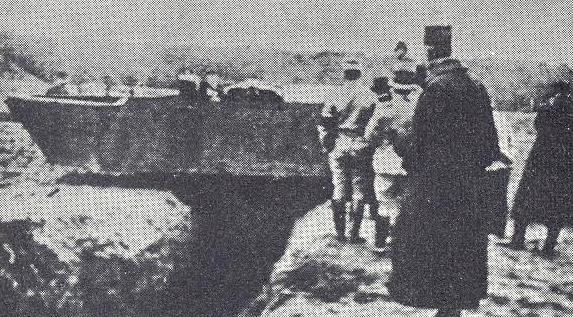
The famous Souain experiment, led in December 1915, was considered to be the first serious army trials of an armored Baby Holt to be derived as a tank platform. Provision for the Breton wire cutters were installed to a provisional wooden hull. General Philippe Pétain was present at these successful trials, which did much to promote the ideas of Col. Estienne.
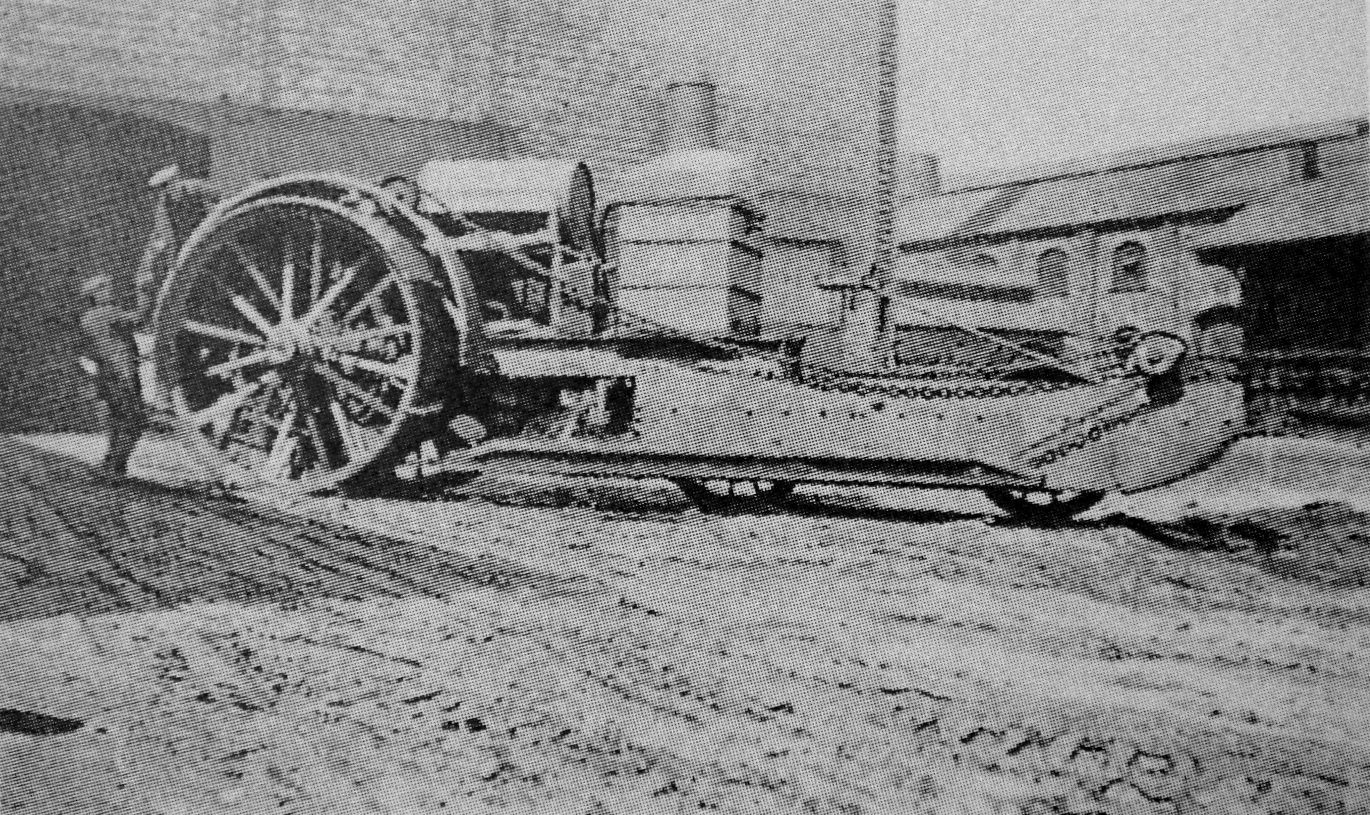
The British Tritton Trench-Crosser, tried in May 1915. This machine was equipped with two 8-foot large tractor wheels, and carried girders on an endless chain, which were lowered and provided a solid grip for the wheels to cross trenches. Cumbersome and complicated, it was abandoned.
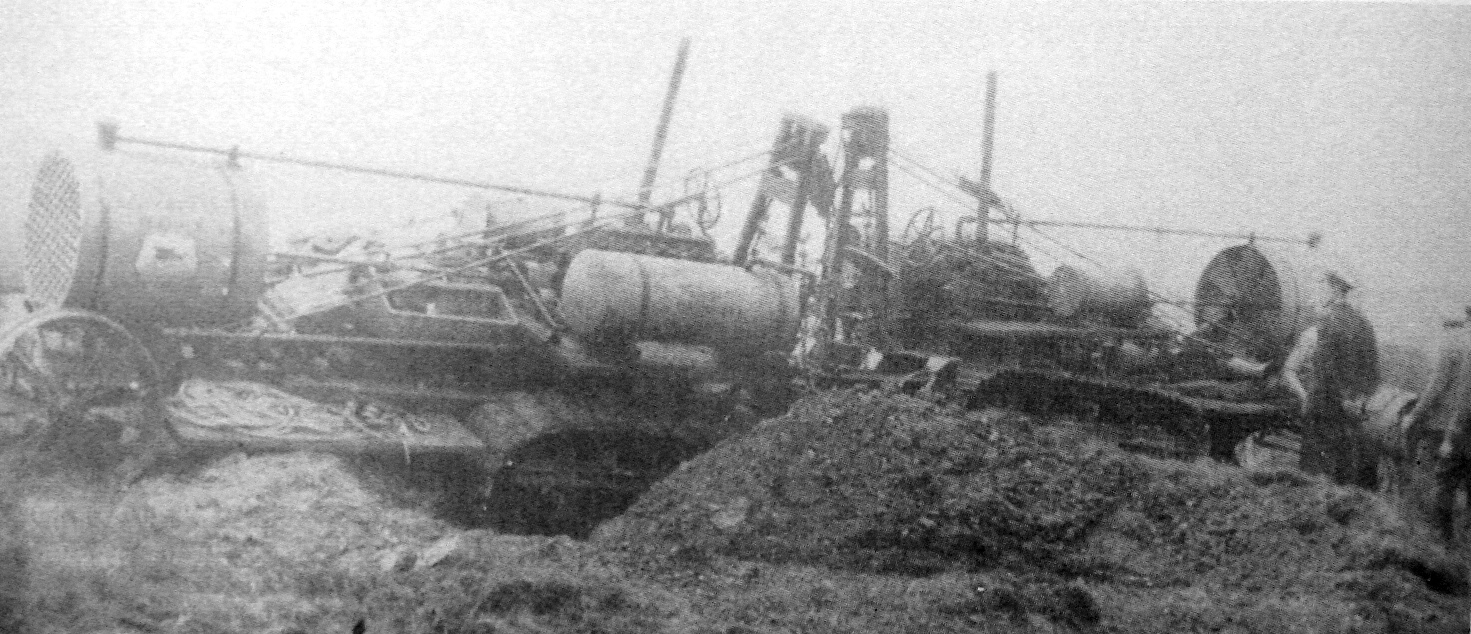
In July 1915, a double-articulated chassis, based on the US Bullock Creeping Grip caterpillar tracks, was tried. This was a relatively sound idea, since this prototype was deemed more agile, but the trials failed nevertheless.
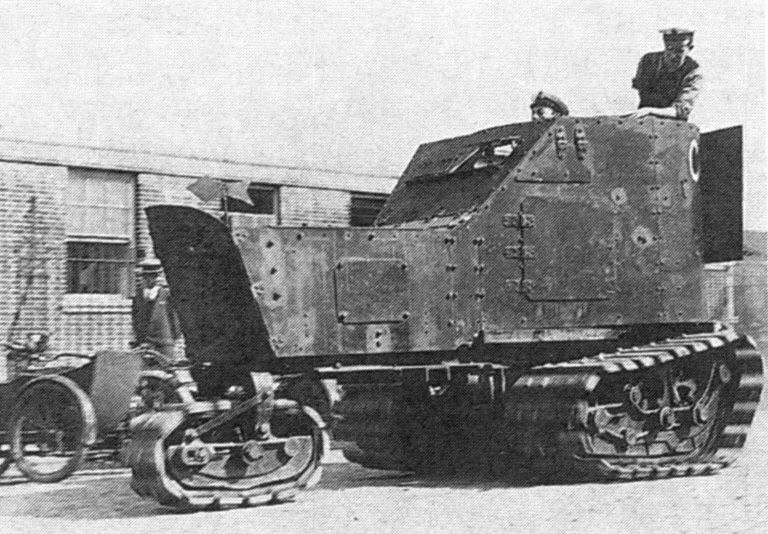
The Killen-Strait tractor was a strange mix tested on 30 June 1915, with a tricycle configuration of two rear tracks and a single front one, which provided steering, and an armored Delaunay-Belleville automobile chassis. Field tests showed the concept to be a dead end as far as trench crossing was concerned.
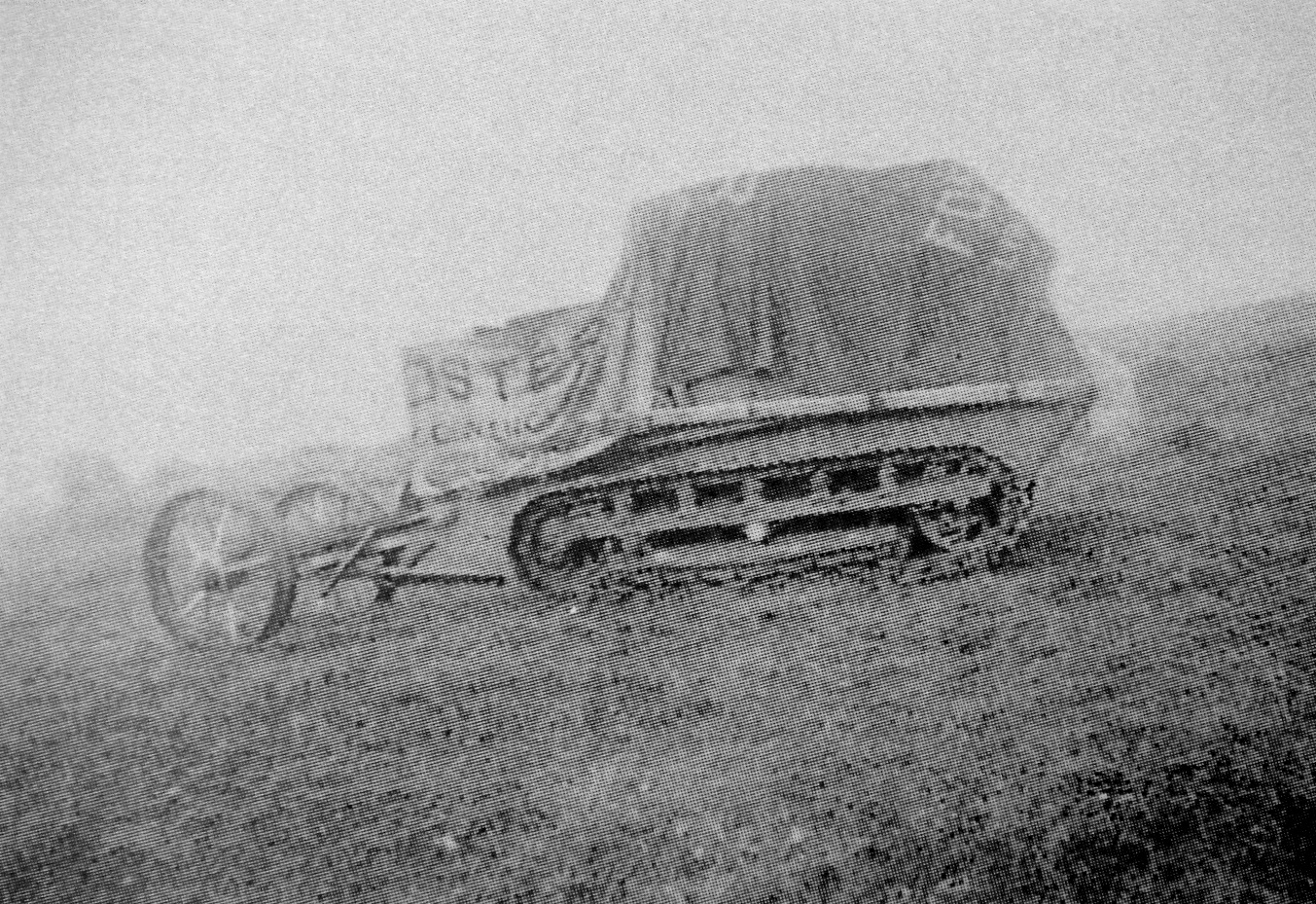
William Tritton's Lincoln number one machine, with Bullock tracks and creeping grip tractor suspension. As a secret project, it is covered by a tarpaulin when not in use. This experiment was also named “Little Willie”, and led to the larger "Big Willie", or "Mother", the ancestor of the entire British rhomboid tank families.
Links about WW1 warfare and armored vehicles
Landships II: Formerly landships.freeservers.com and saved from deletion by its team, this website is perhaps the only comprehensive portal about armored vehicles of the Great War, with most (if not all) types and related resources useful for studies as well as modelling.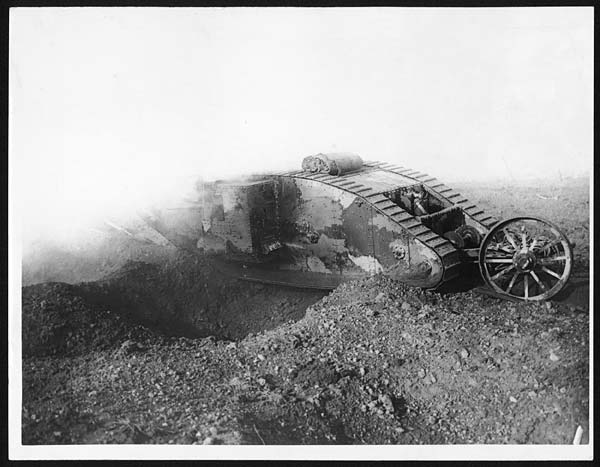
A tank Mark I apparently firing, crossing a trench or shell-hole. CC source
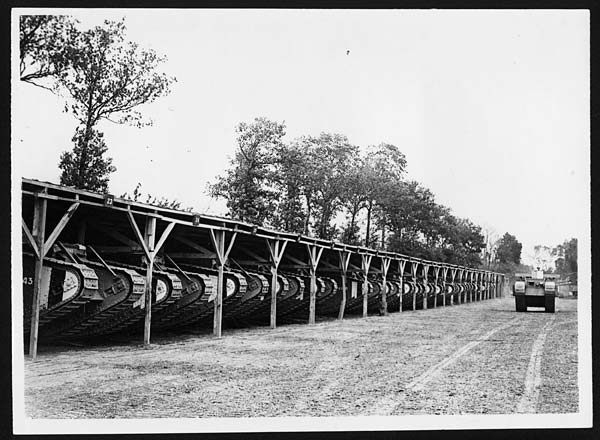
Some of the many stables where our tanks are housed - https://www.europeana.eu/portal/record/9200316/BibliographicResource_3000092751176.html. National Library of Scotland - https://digital.nls.uk/74546950. CC BY-NC-SA - https://creativecommons.org/licenses/by-nc-sa/4.0/
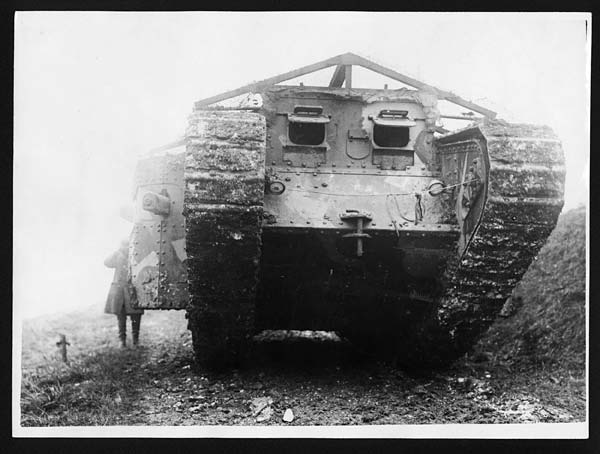
Front view of a tank coming out of action - https://www.europeana.eu/portal/record/9200316/BibliographicResource_3000092750526.html. National Library of Scotland - https://digital.nls.uk/74546690. CC BY-NC-SA - https://creativecommons.org/licenses/by-nc-sa/4.0/
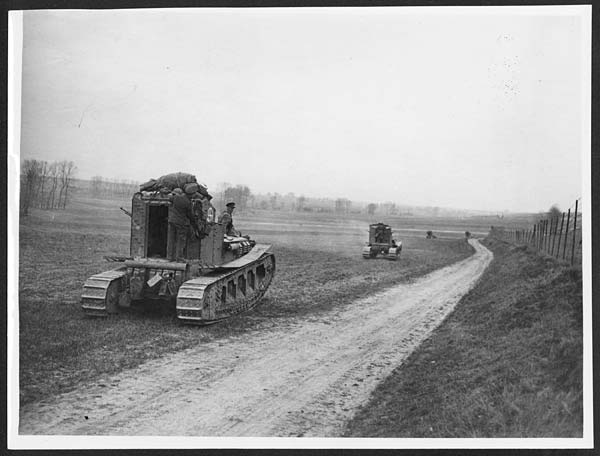
British tanks going forward to check the German advance - https://www.europeana.eu/portal/record/9200316/BibliographicResource_3000092751645.html. National Library of Scotland - https://digital.nls.uk/74548700. CC BY-NC-SA - https://creativecommons.org/licenses/by-nc-sa/4.0/
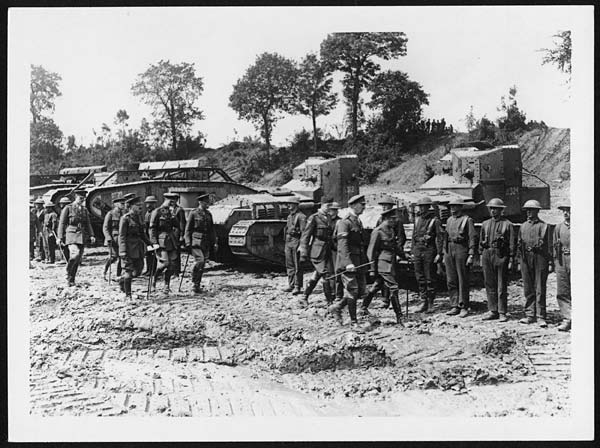
King visits the men who man the tanks at the Front - https://www.europeana.eu/portal/record/9200316/BibliographicResource_3000092751658.html. National Library of Scotland - https://digital.nls.uk/74549154. CC BY-NC-SA - https://creativecommons.org/licenses/by-nc-sa/4.0/
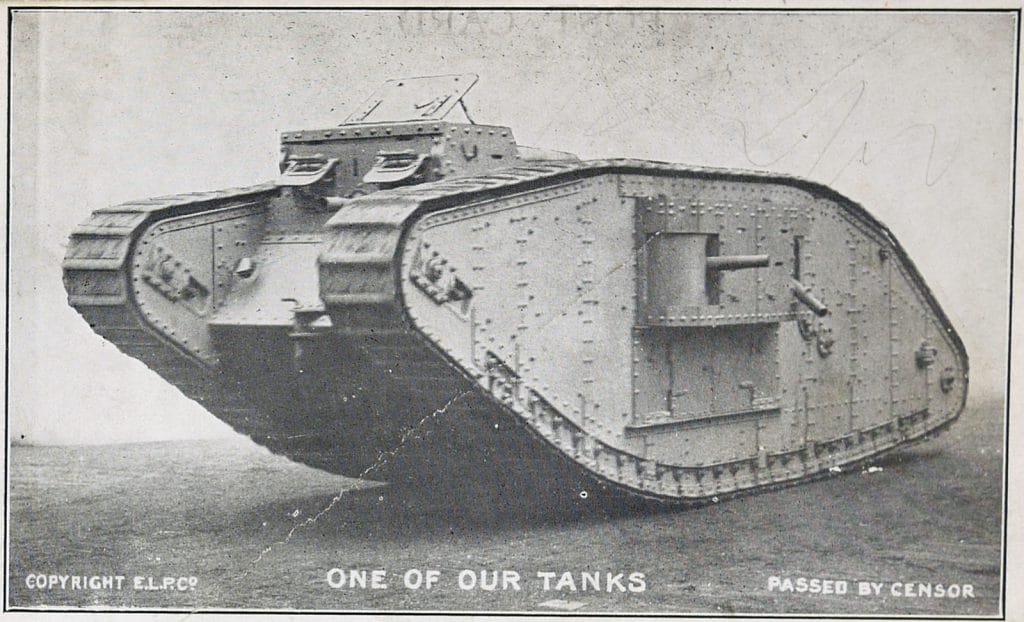
Mark IV Female Tank - https://www.europeana.eu/portal/record/2020601/contributions_18197.html. Europeana 1914-1918. CC BY-SA - https://creativecommons.org/licenses/by-sa/3.0/
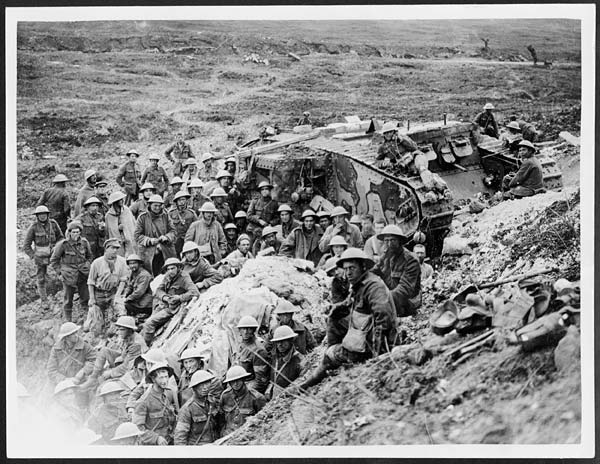
One of our Tanks at Flers - https://www.europeana.eu/portal/record/9200316/BibliographicResource_3000092751948.html. National Library of Scotland - https://digital.nls.uk/74547946. CC BY-NC-SA - https://creativecommons.org/licenses/by-nc-sa/4.0/
One of our Tanks at Flers - https://www.europeana.eu/portal/record/9200316/BibliographicResource_3000092751948.html. National Library of Scotland - https://digital.nls.uk/74547946. CC BY-NC-SA - https://creativecommons.org/licenses/by-nc-sa/4.0/
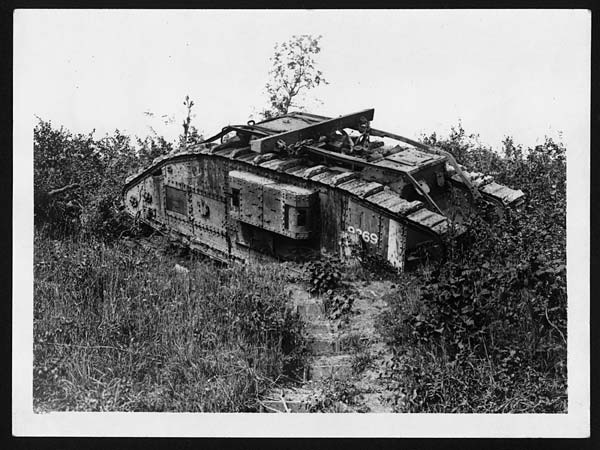
British tank going forward to clear some undergrowth - https://www.europeana.eu/portal/record/9200316/BibliographicResource_3000092751228.html. National Library of Scotland - https://digital.nls.uk/74546976. CC BY-NC-SA - https://creativecommons.org/licenses/by-nc-sa/4.0/
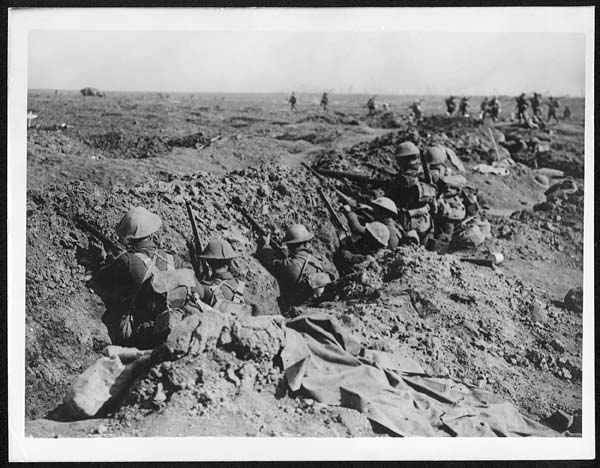
Waiting their turn in advance - tank moving in distance - https://www.europeana.eu/portal/record/9200316/BibliographicResource_3000092751319.html. National Library of Scotland - https://digital.nls.uk/74549286. CC BY-NC-SA - https://creativecommons.org/licenses/by-nc-sa/4.0/
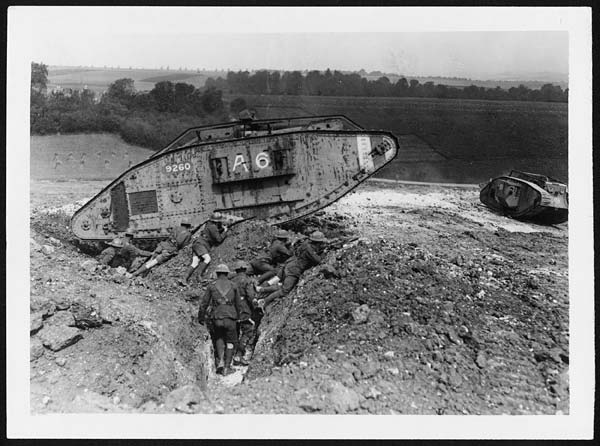
Tanks showing some of their antics during the King's visit to their Headquarters - https://www.europeana.eu/portal/record/9200316/BibliographicResource_3000092751659.html. National Library of Scotland - https://digital.nls.uk/74549152. CC BY-NC-SA - https://creativecommons.org/licenses/by-nc-sa/4.0/
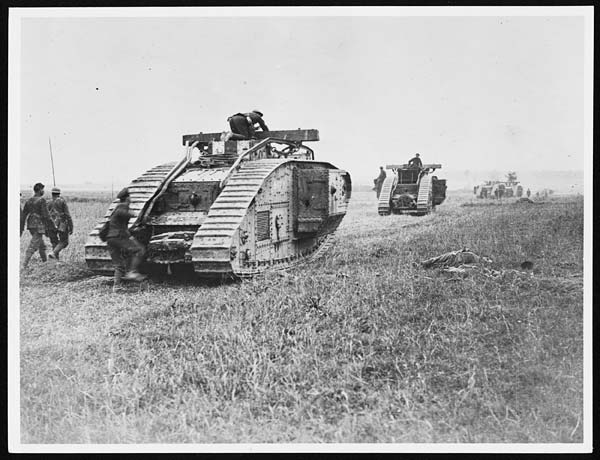
Tanks passing dead Germans who were alive before the cavalry advanced a few minutes before the picture was taken - https://www.europeana.eu/portal/record/9200316/BibliographicResource_3000092752249.html. National Library of Scotland - https://digital.nls.uk/74549216. CC BY-NC-SA - https://creativecommons.org/licenses/by-nc-sa/4.0/
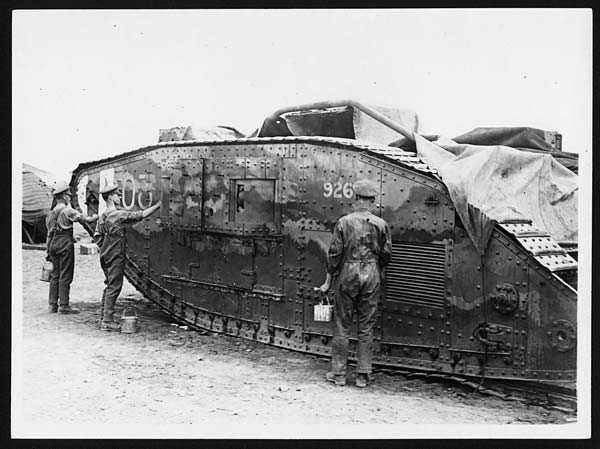
Painting camouflage on a Tank - https://www.europeana.eu/portal/record/9200316/BibliographicResource_3000092751195.html. National Library of Scotland - https://digital.nls.uk/74546948. CC BY-NC-SA - https://creativecommons.org/licenses/by-nc-sa/4.0/